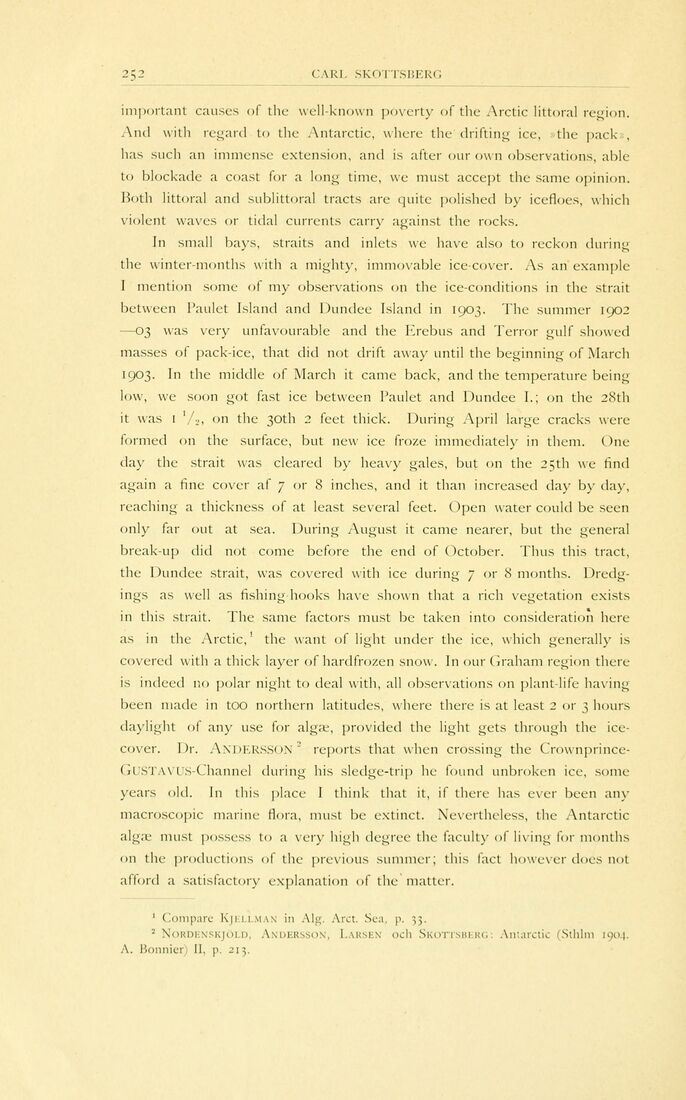
Full resolution (JPEG) - On this page / på denna sida - Sidor ...

<< prev. page << föreg. sida << >> nästa sida >> next page >>
Below is the raw OCR text
from the above scanned image.
Do you see an error? Proofread the page now!
Här nedan syns maskintolkade texten från faksimilbilden ovan.
Ser du något fel? Korrekturläs sidan nu!
This page has never been proofread. / Denna sida har aldrig korrekturlästs.
2 270 caki. skottsberg
important causes of the well-known poverty of the Arctic littoral region.
And with regard to the Antarctic, where the drifting ice, the pack ,
has such an immense extension, and is after our own observations, able
to blockade a coast for a long time, we must accept the same opinion.
Both littoral and sublittoral tracts are quite polished by icefloes, which
violent waves or tidal currents carry against the rocks.
In small bays, straits and inlets we have also to reckon during
the winter-months with a mighty, immovable ice cover. As an example
I mention some of my observations on the ice-conditions in the strait
between Paulet Island and Dundee Island in 1903. The summer 1902
—03 was very unfavourable and the Erebus and Terror gulf showed
masses of pack-ice, that did not drift away until the beginning of March
1903. In the middle of March it came back, and the temperature being
low, we soon got fast ice between Paulet and Dundee I.; on the 28th
it was i ’/2, 011 the 30th 2 feet thick. During April large cracks were
formed on the surface, but new ice froze immediately in them. One
day the strait was cleared by heavy gales, but on the 25th we find
again a fine cover af 7 or 8 inches, and it than increased day by day,
reaching a thickness of at least several feet. Open water could be seen
only far out at sea. During August it came nearer, but the general
break-up did not come before the end of October. Thus this tract,
the Dundee strait, was covered with ice during 7 or 8 months.
Dredg-ings as well as fishing hooks have shown that a rich vegetation exists
in this strait. The same factors must be taken into consideration here
as in the Arctic,1 the want of light under the ice, which generally is
covered with a thick layer of hardfrozen snow. In our Graham region there
is indeed no polar night to deal with, all observations on plant-life having
been made in too northern latitudes, where there is at least 2 or 3 hours
daylight of any use for algæ, provided the light gets through the
ice-cover. Dr. ANDERSSON2 reports that when crossing the
Crovvnprince-GUSTAVUS-Channel during his sledge-trip he found unbroken ice, some
years old. In this place I think that it, if there has ever been any
macroscopic marine flora, must be extinct. Nevertheless, the Antarctic
algae must possess to a very high degree the faculty of living for months
on the productions of the previous summer; this fact however does not
afford a satisfactory explanation of the matter.
1 Compare kjellman in Alg. Aret. Sea, p. 33.
2 Nordenskjöld, Andersson, Larsen och Skottsberg: Antarctic (Sthlm 1904.
A. Bonnier) II, p. 213.
<< prev. page << föreg. sida << >> nästa sida >> next page >>